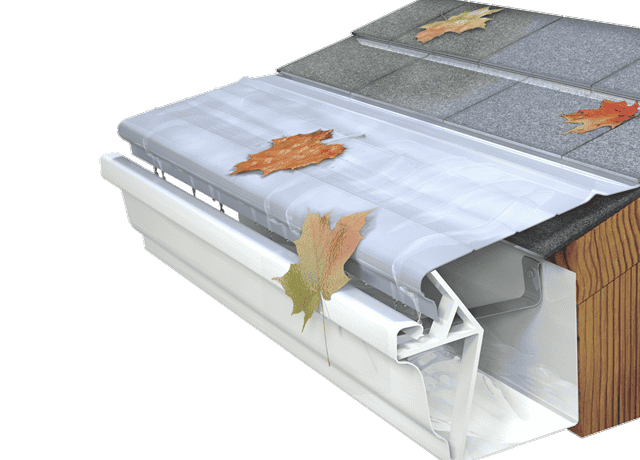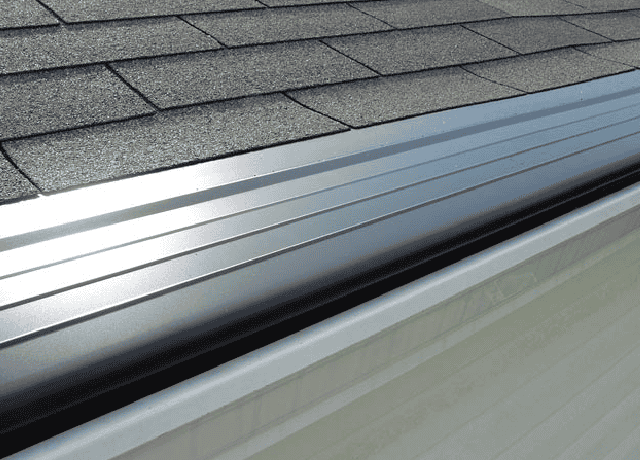Benefits of a Leaf-Guard for Your Gutters

 The gutters and downspouts at the edges of the roof on your home are important for conveying water off the roof and away from the foundation. Unfortunately, all gutters are notorious for collecting outdoor and seasonal debris such as dirt, twigs, autumn leaves and bird’s nests, necessitating at least an annual cleaning.
The gutters and downspouts at the edges of the roof on your home are important for conveying water off the roof and away from the foundation. Unfortunately, all gutters are notorious for collecting outdoor and seasonal debris such as dirt, twigs, autumn leaves and bird’s nests, necessitating at least an annual cleaning.
Who wouldn’t want to avoid the chore of setting up a ladder and clambering to roof’s edge to scoop sodden leaves into a bucket or tarp spread on the ground below? A great, cost-efficient and labor-saving alternative to clogged gutters is professional installation of leaf guards on the entire gutter and downspout system on your home.
Many style and material choices are on the market today, and a reputable home improvement professional can advise the homeowner on what system will work best for his particular situation and budget. Many leaf guard systems are installed when a house is newly built, but an older home can be fitted with leaf guards as well as as long as the existing gutters are in good shape–i.e. are properly secured to the house, are not rusted through and are directing rainwater away from roof and foundation.
The benefits of leaf guards are many, including:
Reducing the difficulty and frequency of cleaning. Most uncovered gutters must be cleaned at least annually. Leaf guards can cut the time frame to 3 to 5 years. The homeowner saves time, aggravation, labor and if cleaning is hired out, money.
Stopping the overflow of water during a storm or rainy season. When gutters are clogged with debris, they can not do their primary job of diverting water away from the foundation and landscape below. Water pooling along a foundation can cause basement damage over time, and excessive water in a garden or lawn attracts wasps, mosquitoes and other insects who love puddles and mud as the perfect breeding ground.
Reducing rust and decay. When metal or wooden gutters gather water-soaked debris, they deteriorate more quickly. Leaf guards protect gutter systems against rust and rot. In addition, wet vegetation gets heavy and can bend gutters out of shape and even pulls them away from the house.
Protecting against fire. In dry climates, gutters that have trapped a lot of debris are fires just waiting to happen. Even the embers from a charcoal barbecue can float through the air, setting crispy dry leaves and twigs ablaze.
Delivering clean, collected water. Some environmentally-conscious homeowners collect rainwater in barrels. The run-off from gutters with leaf guards is much cleaner than rainwater from an unprotected system.
Leaf guards come in various styles and varieties. Some are made of a sponge material which is placed directly in the gutters. Others kinds are wire with bristles, resembling baby bottle brushes. Some leaf guards are made of a thick, synthetic mesh. These kinds of leaf guards are easily installed by a home improvement contractor are invisible from the ground and allow easy visual inspection of the inside of gutters when necessary.
Other leaf guards are termed dome systems. Made of aluminum or plastic, these guards are clipped, screwed or nailed to the roof’s edge, making an awning over the gutter. They allow the rainwater to pass into and through the gutter, but leaves, seeds, and other materials set on top of the meshed dome.
A final note on leaf guards is this: prospective home buyers love low maintenance exteriors. Quality leaf guards can be a great selling point because they protect the home’s exterior and foundation and save on time and money spent on routine outdoor chores.








